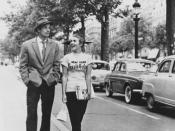François Truffaut Rides In On The New Wave
Since films inception in the late 19th century, film has gone through many changes. What started out as short exhibitionist films and scenics grew into the full feature films that today's population is accustomed to. This, however, was not a fluid progression. The classic hollywood style took an early dominant role in the history of film, with the majority of films following this classical style. They were appealing to the masses, and were very profitable. This style did not appeal to all filmmakers and directors. Since the creation of the cinema, and the classic full feature there have been many movements that have rebelled against the classic style of Hollywood and the commercial cinema. Such movements usually coincided with the intellectual, social, economical and artistic movement of the time. For example, after World War I the Avant-Garde movement begun. It was based off that generations feeling that after the devastation of the war nothing could be the same as before.
The movement was inclusive of the theatre, art, poetry and film. The Avant-Garde movement was heavily influenced by African art, and the movement was not contained to one nation, it was a large and expansive international movement. Another post-WWI movement in film was the Soviet Montage, a smaller movement mainly influenced by the economical and political strains in Soviet Russia.
Unfortunately the world would soon bear the devastation of another world war. The travesty of the war was reflected in the eyes of the new generation of artists. The world around them was rapidly changing. The massive colonial empires were diminishing, though wars still raged in many of the previous colonies, especially on the African continent. Filmmakers at this time in France felt that the heavily commercialized and large, over the top...


![Image taken from page 107 of 'The History and Traditions of Ravenstonedale, Westmorland. [With plates.]'](https://s.writework.com/uploads/16/168402/image-taken-page-107-history-and-traditions-ravenstonedale-w-thumb.jpg)